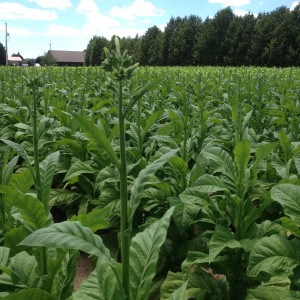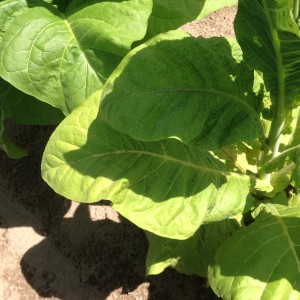Currently most crops are in the rapid growth stage. Earlier planted fields are at or approaching the stretch–bud stage. Topping has already begun on some farms.

Field at stretch-bud stage, which is ideal time for topping. Delayed topping can reduce yield up to 27.5 kg/ha per day.
Aphids are starting to be seen in several fields. Scouting of fields, particularly around a field’s perimeter should be undertaken to determine if the treatment threshold has been reached. OMAFRA’s Publication 843, Flue-Cured Tobacco Crop Protection Guide, provides information on thresholds, products and rates for control of aphids and other insects.
Stink bugs are being seen in several tobacco fields, however, there have not been any situations observed where significant economic loss has occurred.

Tobacco plant showing symptoms of feeding from stink bugs. Leaves in growing point are wilted. A stink bug can be seen on the plant’s stalk just below the lowest wilted leaf.
Frequent and abundant rains earlier in the season caused leaching of nitrogen in several fields and resulted in the tobacco in some of these fields to turn pale in colour. Most growers have been actively applying nitrogen to compensate for leaching losses. This week we are seeing much better colour in several of these fields.
On some farms, nematode injury to tobacco roots in sandier areas of fields has been observed. Plants in these areas tend to be uneven with the smaller plants having root damage from root-lesion nematodes. Soil conditions were less than ideal when fumigation occurred on some farms, which reduced the effectiveness of the fumigant. In addition, root growth earlier in the season has been less than it would have been normally had it been drier and warmer. As a result, nematode feeding on a plant with a less developed root system has had a greater effect than if the roots had been more actively growing.
There has been further incidence of Black Root Rot affecting tobacco growth in fields. The origin of the disease was again determined to be from greenhouse trays. Unless Styrofoam plug trays are properly sterilized following use each year, it is not uncommon for the fungus to build up in the trays and infect the plants. Disinfection of Styrofoam plug trays with steam is advised to control Black Root Rot. For more information on Black Root Rot and its control, please refer to the technical bulletin entitled “Tobacco Pests and Disorders in the Field – Black Root Rot” posted in the Plant Protection area of this website.
Earlier this month, we started to see symptoms of infection from Potato Virus Y (PVY) on a small number of tobacco plants in some fields. It is not known as to how significant PVY will become this year. Spread of PVY is primarily by aphids. Control of aphids in tobacco may help to reduce spread of the disease from infected plants within a tobacco field. For more detailed information about PVY, please refer to the technical bulletin entitled “Tobacco Pests and Disorders in the Field – Potato Virus Y” posted in the Plant Protection area of this website.
There have been further reports of Blue Mold in the United States. In Connecticut and Massachusetts, Blue Mold has been found on broadleaf and shade tobacco. States reporting the disease earlier were Pennsylvania and Tennessee. Up until now there have been no reports of Blue Mold in Ontario. Growers should routinely scout fields for signs of Blue Mold. Information about identification of Blue Mold and its control can be found in the technical bulletin entitled “Tobacco Pests and Disorders in the Field – Blue Mold” posted in the Plant Protection area of this website and in OMAFRA publications 842 and 843. If you find Blue Mold, please report it immediately.
Post prepared and sent by Canadian Tobacco Research Foundation
Mailing Address: CTRF, P.O. Box 322, Tillsonburg, ON N4G 4H5
Telephone: 519-842-8997
Web Address: https://ctrf1.com


